
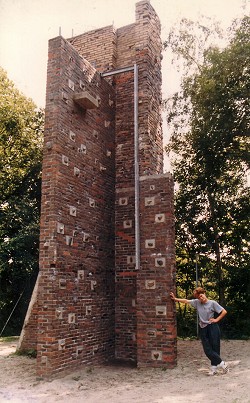
I met some members of the local university climbing club - the GSAC (pronounced hay-sac with a bit of a grizzle on the 'hay'). I showed them some of my problems hoping they would show me some of theirs. After a few minutes I realised that my problems were completely new to them, not only that but the idea of using the brick edges was new to some, and most of them couldn't repeat any of my problems. It was a curious feeling when compared to back in Sheffield where I was just another E3/4 leader amongst a lot of much better climbers; in Groningen I was suddenly a ground-breaking visionary first ascensionist!
Over the next few days I arranged to meet up with them some more, and made good friends with Gert (pronounced 'Hert') van der Veen one of the most active of the GSAC members. We had a great time and I felt like a superstar and eventually I joined them on a weekend trip to Freyr in Belgium.
Roll on 23 years to March 2009 and another visit to Holland for an Easter trip with the family. I am not as obsessed these days but the recent enthusiasm shown by my eldest daughter meant that we were keen to find a wall to climb on during our stay, and we were once again in the Groningen region.
I checked out the local walls on klimgids.climbing.nl and discovered an amazing looking place actually in Groningen called Bjoeks (pronounced as the crag Buoux). I emailed the wall just to check if it would be open. The reply was friendly and welcoming but also contained the line, "you are not the Alan James who visited Groningen 20-odd years ago and did lots of desperate problems on our tiny bouldering wall are you?" ... and suddenly, there he was, Gert, my friend from years before.
Small world it is, especially in the field of Dutch climbing!
We visited the wall and what an eye-opening experience we had. Not only was it a superb and large wall, but everything about it seemed as far ahead of the UK walls as the old brick edge thing had been behind in the 80s. The building was a top-notch ground-up construction designed by an architect, with creatively-angled walls, high standard fixtures and fittings and at least as big as most UK walls. Gert said that he had wanted to build something of the best quality so that when he finally finished paying it off, he would have something of real value. As it turns out, he has done better than expected and has been able to add extra walls and expand.
Gert told me how it had started for him: "I started Bjoeks in 1996 with a friend of mine, Alco Pols - he's the technical one and I do the rest. Together we own Bjoeks and Polsar Klimelementen where we build climbing walls in schools and for the military. After university I worked a few years in the gas industry and in research. Alco was a good climbing friend of mine. At a certain point we spent way too much time sitting in bars, drinking beer and talking about climbing centres so we decided it was time to make a business plan so as to know at least why it would never work. Well, in the end it did work thanks to careful planning and the climbing wall business that started to earn some money."
In addition to the internal walls there was plenty of climbing outside including some great free-standing boulders, and inside-outside bouldering block/cave, and the breath-taking Excalibur Tower.
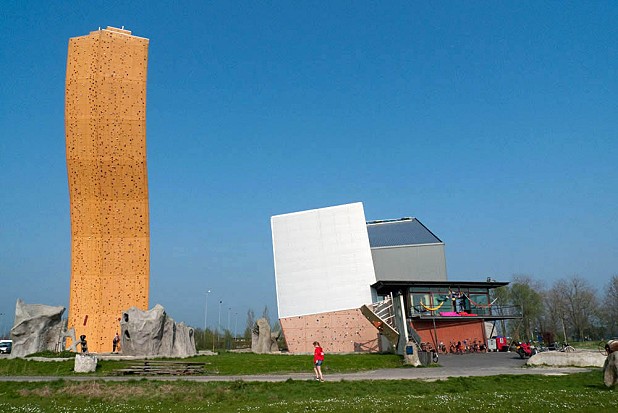
At 37m tall it is the tallest free-standing climbing wall in the World; a notch higher than Stone Works wall in Carrollton in Texas, USA. There are some taller walls on the side of buildings and dams, but nothing on a purpose built structure. Our first route tackled the slabby side, wandering up the gentle wave past the odd tiny patch of lichen, and left us perched on the top, in a magnificent position and higher than anything else for miles around.
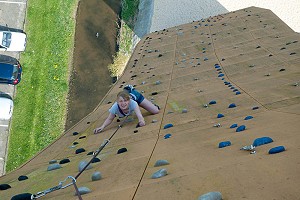
Dutch climbing walls don't need to compete with many outdoor crags so external development is an obvious direction for them to go in and this has had the effect of creating a more year-round market. Gert has also pitched the wall well, aiming at a fairly moderate standard of climber with the steep stuff being available but not dominant. He acknowledged to me that climbing in Holland is very different to the UK since there is very little impression amongst the general public about the sport. The perception of Everest, the Alps and snowy mountaineering epics is significantly more entrenched in the public psyche than here in the UK where most people will have some idea about rock climbing (having seen "that French girl on the telly"), even if they don't know the precise difference from mountaineering. The actual concept of a climbing wall is something completely alien to most Dutch people though and Gert's marketing has to be on a very basic level. He also has to supply all the kit - ropes, gri-giris and Bjoeks-branded harnesses.
Gert describes his philosophy, "As a 'moderate' all rounder my focus is more on the whole pyramid with a broad base of beginners (up to F5+), a pretty big group of F6a - F7a climbers and a handful of F7a+ climbers that for a big part are useful for route setting and doing all sorts of jobs for their year-card since they are very involved with the climbing centre. To give an idea: maybe 30 regulars climb F7a or more and only 4 or 5 ever did F8a or more."
Over the years I have visited a few other walls in Holland - Utrecht, Eschede, Arnhem, Nijmegen - and they all tend to be in this same high-quality end of the market, being more like UK tennis clubs than the converted-warehouse style of many UK walls and this reflects a more business-like approach to climbing.
Gert comments, "In the Netherlands there's a bit of a split between climbing centres set up by outdoor-business people and those that are set up by climbers. They reflect conflicting notions of what climbing is. The outdoor ones sell climbing as a fun activity for everyone and the climber-run centres as a way of self expression for a dedicated elite. I my opinion climbing can be a lot of things to a lot of different people and a succesful business model tries to be host for as many of those as possible. For me it means the best facilities imaginable that make it easy to motivate people. It also means a separation of the fun groups (that always climb under strict supervision) and the 'normal' climber that is in principle responsible for his own actions. It also means a personal, relaxed, non or not-too competitive atmosphere that allows people to maximize their own personal experience."
I remember in Utrecht being very impressed with the route setting and this is exactly what we found again at Bjoeks. Imaginative routes taking intricate lines up the wall even if there were no features. One route I did tackled an interesting vertical pillar to a rest at the top of the pillar. Above was a 8m leaning vertical wall which most would be content with finishing up directly having already tackled the pillar below, however there were no yellow holds above. My first thought was half a route, not yet finished, then I glanced right and saw three big yellow undercuts and in between two tiny finger holds. They were far enough away to be on the next same-coloured route but in fact they weren't, that was where this one went. A quick finger-traverse above the lip of a roof followed by some exposed pulling on the undercuts gave me one of the most memorable and outdoor-like moves I have ever done on an indoor wall. I can't remember the last time I was on a route on a UK wall and had to think, "where does it go next?", yet when I did find it, the solution was tricky but still at the expected grade. This was the case on all the routes we did, subtle moves which required thought rather than just straight pulling power - a bit like outdoor routes really!
So are the Dutch walls ahead of the UK walls? In some aspects, yes. They are plusher, often more extensive and have some outstanding lead walls. This isn't to say that UK walls are rubbish; there are certainly many great and atmospheric walls in the UK, brilliant church conversions, some stylish ground-up creations, and one or two cobbled together places with add-on sections giving great character. I think that there is more money in Dutch climbing; the prices tend to be higher - 10 Euros for a climb is around £9 at today's bad exchange rate - and the sport appeals more to those with a bit more money. The summer market also helps a lot - "Originally summer was definitely the low season as it is for most climbing centres worldwide. With the outdoor facilities that we have now built we have managed to make the difference between summer and winter a lot smaller. Only the height of summer during 3 or 4 weeks it is really a lot quieter at night due to people being on holiday. For the school groups of course July and August are dead months as well", says Gert.

As previously mentioned, one feature that does seem to put Dutch walls ahead of their UK counterparts is the route setting. I wondered why this might be since I doubt that the route setters themselves are any more skilled or experienced. After our visit I asked Gert his thoughts:
"For one, we have an abundancy of holds thanks to the fact that we make them ourselves. The other factor is that I take care to select my route setters with care (not necessarily top climbers but intelligent, creative people) and tell them explicitly that the emotions that their routes evoke with the guests is my core product. This may seem vague but is in my opinon the essence of climbing - good moves make you happy. Finally we stimulate feedback from the guests and from other route setters so as to learn."
Now I haven't been to every wall, but I don't think that many wall managers in the UK put this much thought into their route-setting as this. A lot of route setting seems to be more of a chore than a creative process. Whilst UK route setters are sure to have pride in what they do, the end results are often slightly repetitive and tend to create routes which flow obviously rather than pose questions. It is not that route setting in the UK is bad, but I think it can be improved on and any budding route setter could do worse than pay a visit to somewhere like Bjoeks to see what can be acheived.
One area which Dutch walls tend to fall short is that of high quality bouldering although Bjoeks is good in this respect. I asked Gert why he thought this might be the case: "10 to 15 years ago bouldering was not a very big thing yet in Holland. Since a lot of climbers got their introduction into climbing via alpinism or sport climbing, bouldering was seen as more of an in-crowd thing, or even not real 'climbing'. Of course this has changed recently as people have discovered that, in order to get stronger, you simply have to boulder a lot. The established walls presented climbing as doing something on a rope high above the ground and newcomers were not educated into climbing with an impression of how much fun bouldering can be. The bouldering facilities that were added to existing climbing centres tended to be dirty holes in the wall full of half-naked muscle men - not a great incentive to pick up bouldering for your average beginner. Making bouldering popular for the average climber is good business since they are less dependant on climbing mates when bouldering and they're more motivated since they improve their level faster. The indoor bouldering wall, but especially the outside boulders, at Bjoeks we make an effort to present bouldering as another climbing experience - relaxed, playful, creative, effective and social. The wall in Eindhoven recently opened a state of the art bouldering wall (MONK) and I'm sure it will help as well to give bouldering a push."
Not all climbing walls in Holland are anything like as good as the Bjoeks wall which is undoubtedly the current state of the art. As an example it something to aspire to on many levels; it is run on a simple and profitable business model and makes decent money even in this recession; it appeals to climbers of all abilities and disciplines; it is a pleasant place to be and to climb and there is a great attention to detail everywhere you look, from the route-setting to the tidy changing rooms; the Excalibur tower is an outstanding feature which makes it the only wall I have ever visited which I will consider training for before my next visit since standing on the top really does feel like you are on the summit of a Dutch Mountain!
Some Useful links (mostly in Dutch):
Too Much Top-Roping - December 2017 Footnote
I have now climbed at several other large climbing centres across the Netherlands and I can confirm the last paragraph above since so far I have found no other wall that comes close to Bjoeks in 2009 both in extent and also the style of climbing offered. There are many excellent centres but many of them are totally dominated by top-roping, so much so that leading is an excentric past-time that isn't even allowed at some walls. In fact the Bjoeks centre itself is not as good as it used to be as they too now focus on the top-roping market which dominates in Holland. It isn't just the fact that, as a lead climber, you have less to go at, the routes tend to be set for top-roping leaving you with nasty clips in mid-move, or weaving lines with no clear set of bolts.
The rules in the walls also seem to be curious and contradictory. The term 'slip-belaying' has been invented to cover the practice of sliding your hand up the lower belay rope as you feed the rope through. This is perfectly safe, especially with an assisted breaking belay device, but you may well find yourself being told off for doing it and asked to belay in an unfamiliar way. Meanwhile the top-roping of very steep routes leads to some extremely dubious situations where large people (the Dutch are quite tall) take huge swinging falls from low on a route, across the crowded centres, scattering climbers like skittles. Also, reclipping the top-rope into the quickdraws on these routes is a tiresome and fraught procedure that regularly leaves inexperienced climbers making epic swings across space.
Before you visit a wall, it is worth checking with the wall to see if lead climbing ('voorklimmen') is allowed. Most will allow it at quiet times but the choice of routes is usually very limited and you will often have to wrestle with the fixed top-rope on the route already. If there is a dedicated lead wall then it is usually small and tucked away (expect the Excalibur tower which remains briliant).
I can understand why the Dutch walls have gone this way since climbers in the Netherlands tend to be indoor climbers, who don't own ropes, or even climb outside very often - they are just catering for their market. You will still find some great tidy centres with impressive lead wall structures, but the experience is often disappointing for those of us who fully appreciate lead climbing.
- DESTINATION GUIDE: The Best of Peak Limestone Sport Climbing (6a – 7a) 9 Jan
- REVIEW: Dolomite Crodarossa Hi GTX Boot 21 Jun, 2022
- REVIEW: Scarpa Gecko Approach Shoe 11 Jan, 2022
- REVIEW: Red Chili Mystix 16 Jul, 2021
- PHOTOGRAPHY: Three Generations on Wall End Slab 12 Jul, 2021
- REVIEW: Arc'teryx Creston Pant 25 Sep, 2020
- VIDEO: Removing Loose Rock at Horseshoe 20 Jul, 2020
- REVIEW: Montane Protium Pull-on 16 Jun, 2020
- REVIEW: Lowe Alpine Rogue 48 5 Jun, 2020
- FEATURE: The Story of a Cartoon and Satire in the '90s 1 Apr, 2020

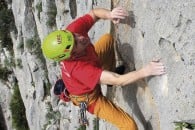

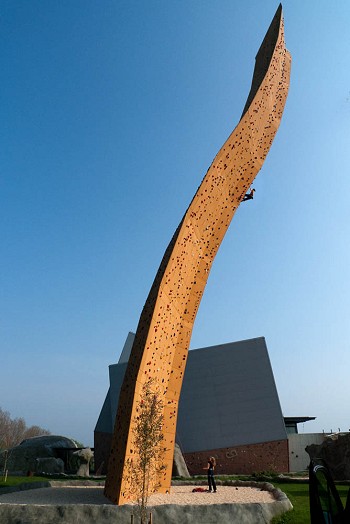
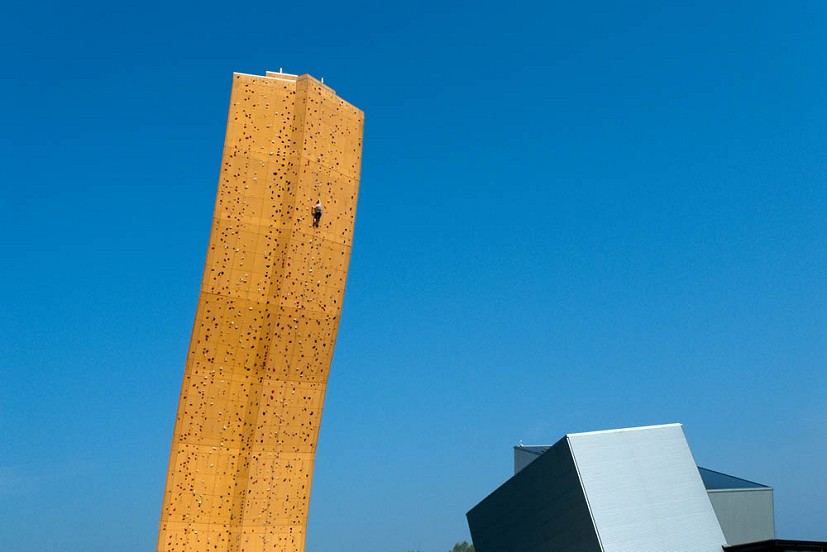

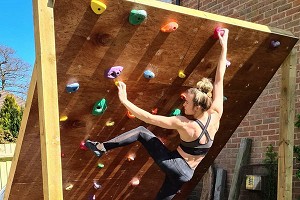
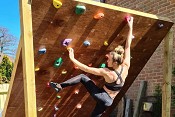
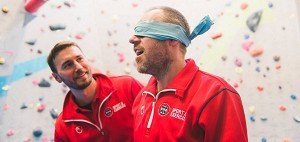









Comments